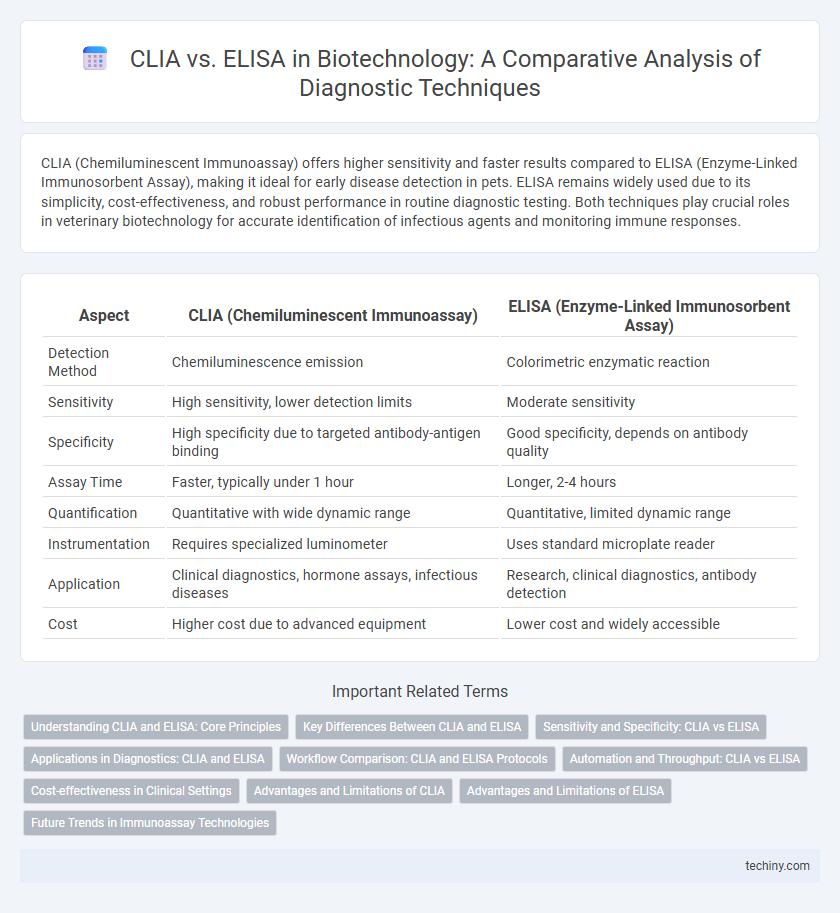CLIA (Chemiluminescent Immunoassay) offers higher sensitivity and faster results compared to ELISA (Enzyme-Linked Immunosorbent Assay), making it ideal for early disease detection in pets. ELISA remains widely used due to its simplicity, cost-effectiveness, and robust performance in routine diagnostic testing. Both techniques play crucial roles in veterinary biotechnology for accurate identification of infectious agents and monitoring immune responses.
Table of Comparison
| Aspect | CLIA (Chemiluminescent Immunoassay) | ELISA (Enzyme-Linked Immunosorbent Assay) |
|---|---|---|
| Detection Method | Chemiluminescence emission | Colorimetric enzymatic reaction |
| Sensitivity | High sensitivity, lower detection limits | Moderate sensitivity |
| Specificity | High specificity due to targeted antibody-antigen binding | Good specificity, depends on antibody quality |
| Assay Time | Faster, typically under 1 hour | Longer, 2-4 hours |
| Quantification | Quantitative with wide dynamic range | Quantitative, limited dynamic range |
| Instrumentation | Requires specialized luminometer | Uses standard microplate reader |
| Application | Clinical diagnostics, hormone assays, infectious diseases | Research, clinical diagnostics, antibody detection |
| Cost | Higher cost due to advanced equipment | Lower cost and widely accessible |
Understanding CLIA and ELISA: Core Principles
Chemiluminescence Immunoassay (CLIA) utilizes luminescent molecules to produce light signals for detecting target analytes with high sensitivity, whereas Enzyme-Linked Immunosorbent Assay (ELISA) relies on enzyme-substrate reactions generating a colorimetric change measurable by spectrophotometry. CLIA offers enhanced signal amplification and lower detection limits compared to ELISA, making it suitable for detecting low-abundance biomarkers in clinical diagnostics. ELISA remains widely used for its simplicity, cost-effectiveness, and versatility in quantifying proteins, antibodies, and hormones across various research and diagnostic applications.
Key Differences Between CLIA and ELISA
CLIA (Chemiluminescence Immunoassay) and ELISA (Enzyme-Linked Immunosorbent Assay) differ primarily in detection methods, with CLIA using chemiluminescent signals and ELISA relying on colorimetric changes. CLIA typically offers higher sensitivity and faster results due to its signal amplification, whereas ELISA is widely used for its simplicity and cost-effectiveness. Both assays target specific antigens or antibodies but vary in dynamic range, automation potential, and susceptibility to interference.
Sensitivity and Specificity: CLIA vs ELISA
Chemiluminescent Immunoassay (CLIA) generally exhibits higher sensitivity and specificity compared to Enzyme-Linked Immunosorbent Assay (ELISA), allowing for more precise detection of low-abundance biomarkers. CLIA's enhanced signal amplification reduces background noise, resulting in fewer false positives and improved diagnostic accuracy. ELISA remains widely used due to its simplicity and cost-effectiveness but may show lower sensitivity in detecting subtle antigen-antibody interactions.
Applications in Diagnostics: CLIA and ELISA
CLIA (Chemiluminescence Immunoassay) offers higher sensitivity and faster turnaround times for detecting low-abundance biomarkers in infectious disease and cancer diagnostics. ELISA (Enzyme-Linked Immunosorbent Assay) remains widely used for quantifying antibodies and antigens due to its cost-effectiveness and adaptability in clinical laboratories. Both techniques are essential in diagnostic workflows, with CLIA preferred for automated high-throughput testing and ELISA suited for routine screening and research applications.
Workflow Comparison: CLIA and ELISA Protocols
CLIA protocols typically offer higher sensitivity and faster turnaround times compared to ELISA, leveraging chemiluminescent substrates for signal detection. ELISA workflows often involve multiple incubation and washing steps, resulting in longer processing durations and manual handling. Automation compatibility in CLIA enhances throughput and reduces variability, whereas ELISA remains widely used for its simplicity and cost-effectiveness in diverse laboratory settings.
Automation and Throughput: CLIA vs ELISA
Chemiluminescence Immunoassay (CLIA) offers higher automation compatibility and throughput compared to Enzyme-Linked Immunosorbent Assay (ELISA), making it ideal for large-scale diagnostic laboratories. CLIA platforms integrate advanced robotic systems that streamline sample processing, reducing hands-on time and increasing assay speed. ELISA, while reliable, typically requires more manual intervention, limiting its scalability and throughput in high-demand settings.
Cost-effectiveness in Clinical Settings
CLIA (Chemiluminescent Immunoassay) offers higher sensitivity and faster turnaround times compared to ELISA (Enzyme-Linked Immunosorbent Assay), which can translate into cost savings by reducing labor and workflow bottlenecks in clinical laboratories. Although ELISA kits are generally less expensive per test, CLIA's automation and reduced reagent use often result in lower overall operational costs in high-throughput settings. Clinical settings prioritizing cost-effectiveness must weigh ELISA's affordability against CLIA's efficiency gains to optimize diagnostic accuracy and resource utilization.
Advantages and Limitations of CLIA
Chemiluminescence Immunoassay (CLIA) offers high sensitivity and specificity compared to Enzyme-Linked Immunosorbent Assay (ELISA), enabling the detection of low-abundance biomarkers with rapid turnaround times suitable for clinical diagnostics. CLIA's automated platforms reduce human error and increase throughput, making it ideal for large-scale testing environments. Limitations include higher costs, the need for specialized equipment, and potential signal instability due to chemiluminescent reagent decay.
Advantages and Limitations of ELISA
ELISA offers high sensitivity and specificity for detecting and quantifying proteins, antibodies, and hormones, making it ideal for diagnostic and research applications. Its scalability and relatively low cost facilitate high-throughput screening, while colorimetric, fluorescent, or chemiluminescent readouts provide versatile detection options. However, ELISA requires well-characterized antibodies and can be limited by cross-reactivity, potential false positives, and longer assay times compared to automated methods like CLIA.
Future Trends in Immunoassay Technologies
Emerging immunoassay technologies are enhancing sensitivity and specificity beyond traditional CLIA and ELISA methods by integrating nanomaterials and microfluidics for point-of-care applications. Advances in multiplexing and digital immunoassays are enabling simultaneous detection of multiple biomarkers with greater accuracy, accelerating personalized medicine development. Machine learning algorithms combined with immunoassay data are improving diagnostic interpretation, supporting real-time decision-making in clinical biotechnology.
CLIA vs ELISA Infographic

 techiny.com
techiny.com